The grand presentation is coming soon. The flashy renderings. The attention-grabbing video. The slide presentation to explain the financial dynamics. The Chicago Bears have reached the next step in their ambitious push for a fixed-roof stadium folded within a reimagined Museum Campus off the shores of Lake Michigan.
But first, team President and CEO Kevin Warren must sell the Bears’ vision in a convincing manner that creates more unity than division, more excitement than trepidation. That’s among Bears fans, sure. But more so, the pitch must land compellingly with city officials, state legislators, residents of Chicago and Cook County plus the leaders of the Friends of the Parks group. And it must further the momentum Warren has felt building in recent months.
“With all these projects, that’s a great word. They require momentum,” Warren said. “They require vision. They require tenacity. They require a lot of thought and planning. But they also require momentum. And I strongly believe we’re building momentum to that museum area.”
Warren gushes when discussing Chicago and the downtown area specifically. He speaks often about how the majestic architecture of the city’s skyline intersects with the glimmering water of Lake Michigan. He views that as the perfect backdrop for the grand new stage on which the Bears might one day perform and believes the entirety of the project can heighten the prestige of the team, the Museum Campus and, to a significant extent, the city.
“We think this is an extraordinary opportunity,” Bears Chairman George McCaskey said, “for Bears fans, for the Museum Campus, for the city and for the region.”
Added Warren: “The energy in downtown Chicago is really unique. We just want to bring that campus to life.”
To do so, the Bears won’t take their biggest swings blindly. They’re equipped with wisdom from how other NFL teams and cities handled their stadium projects over the past 20 years. That includes the Minnesota Vikings, who opened U.S. Bank Stadium in Minneapolis in 2016 after a yearslong process of which Warren was an integral part as the team’s chief operating officer.
The Las Vegas Raiders, Dallas Cowboys, Indianapolis Colts and Atlanta Falcons also completed stadium projects with notable success.
Raiders President Sandra Douglass Morgan only recently finished processing the impact of Super Bowl LVIII on Las Vegas this winter. Douglass Morgan also has witnessed firsthand how Allegiant Stadium, which opened in summer 2020, has added to the city and surrounding community as a 365-day-per-year venue for everything from football’s grandest game to much smaller banquets and private events.
A recent team-issued survey, according to Douglass Morgan, revealed that more than 70% of out-of-town visitors to the stadium came to Las Vegas specifically for the event there — be it a Raiders game, a concert or another happening.
“I think there’s a notion that 40 million people come to Las Vegas annually and (millions) just happen to wind up at Allegiant,” Douglass Morgan told the Tribune. “No. They are coming and they’re traveling because of the world-class stadium we have built there and the events we attract.”
Warren is confident the Bears’ stadium pitch can have a similar impact on Chicago.
“This will set this city up for greatness for the next 100 years,” he said
But how exactly? At what cost? And what’s next?
At present, the Friends of the Parks organization continues urging the Bears to consider alternative city sites outside the Museum Campus, emphasizing its aim to limit development along the lakefront. Resistance from the group likely will be just one significant obstacle for the Bears, particularly after the its opposition proved influential in thwarting filmmaker George Lucas’ plans to build a museum in the same area.
Then there’s the funding issue. When the Bears pivoted from their proposal to build on their $197 million Arlington Heights property, they announced plans for a $2 billion private investment to the lakefront stadium project. But public money will still be needed as the city and team consider both stadium construction plus necessary infrastructure improvements.
In addition, the Bears’ push to build a lakefront stadium comes at a time when the White Sox are exploring their own stadium project on a strip of land known as “The 78” in the South Loop, raising concerns about the funding feasibility for two such mega projects.
What’s the plan?
Whenever the Bears deliver their formal presentation, which is expected this month, they must come ready for a long list of questions about how all this will be possible. The issues the team must be prepared to address include but are not limited to:
- What are the details of the public-private partnership the Bears will be seeking to fund a project likely to surpass $3 billion for the stadium alone? And with the wide array of infrastructure enhancements needed, what will the estimated cost of the entire project look like?
- What projected economic impact do the Bears foresee that would qualify a project of this scale as beneficial for all involved?
- What upgrades, amenities and new elements does the team propose to incorporate within the Museum Campus?
- How will this project address significant concerns with traffic, parking and limited public transit that currently exist with Soldier Field?
- Finally, how will the Bears work through anticipated resistance from those who strongly oppose public funding of professional sports stadiums?
The Bears’ current proposal is to build their new stadium on city-owned land south of where Soldier Field sits, on the footprint where the Waldron Deck and South Lot parking venues currently are. Beyond that, the team hasn’t disclosed its full file of details, which will be necessary to clear up why its pivot away from a potential stadium in Arlington Heights and back to a lakefront venue qualifies as a better option.
With the Bears vowing to contribute more than $2 billion to the proposed public-private partnership, Warren asserts he is viewing this project through the eyes of an urban planner, particularly as it relates to reinvigorating the Museum Campus.
“What we’ve tried to do is to ask: ‘What could we do to bring that area to life even more?’” he said.
The Bears’ presentation likely will include proposals for demolishing Soldier Field while keeping the stadium’s distinctive colonnades intact; creating multiuse playing fields for youth sports and community use; building a hotel plus a limited number of dining and entertainment venues; creating a Chicago-sports-themed museum; and suggesting solutions for alleviating traffic snarls and ingress/egress congestion around the campus.
“We want this area to be very smartly built,” Warren told the Tribune. “We’re not trying to build the Taj Mahal and just throw money in there. And that’s one of the reasons we’re bringing more than $2 billion to the table to say we’re invested in it. Now let’s build a very smart, well-built stadium that the citizens of Chicago and the Chicagoland area and the state of Illinois can look to and say, ‘This is a crown jewel that will create jobs and opportunities and (attract) mega events.’
“Instead of saying this is the Chicago Bears trying to get something (for) free, what we’re trying to say is just the opposite. We want to build our stadium here to create these opportunities to make Chicago the city it really deserves to be.”
Minnesota: A pitch, then a switch
As the Bears prepare to unveil their pitch for a new stadium on the Museum Campus, it’s worth noting that the Vikings delivered a similar presentation in May 2011, proposing to move out of Minneapolis and Hennepin County and to a 430-acre site in suburban Arden Hills.
Warren wasn’t the Vikings COO at that time; he was the organization’s executive vice president of legal affairs and chief administrative officer. But despite the initial momentum the proposed Minnesota Sports Complex in Arden Hills seemed to have, that vision crumbled within a year amid significant funding obstacles plus a thorny political wrestling match that ultimately led the team back to downtown Minneapolis.
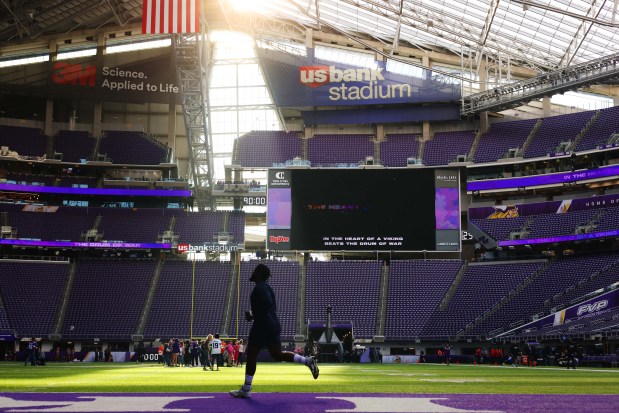
As it relates to the Bears’ current efforts, it’s difficult to forecast whether, like the Vikings, they will wind up with a new stadium in the same area where their current stadium sits — or whether, also like the Vikings, their presentation of an attention-grabbing new complex might wind up as little more than flashy archival artwork if they shift back to their original idea.
In this case, that would mean redirecting focus back to the 326-acre property in Arlington Heights that the Bears purchased in 2021 and closed on last year.
For now, Warren insists the latter option is not his focus.
R.T. Rybak was the Minneapolis mayor during the Vikings stadium venture and fought to keep the franchise playing downtown by reducing strong resistance within the City Council and helping to sell a vision of a mutually beneficial project for the team and city.
One key tenet within that push, Rybak told the Tribune, was demonstrating potential for development in the immediate area around the stadium. That ultimately came when financial services giant Wells Fargo agreed to invest, expanding its Minneapolis operations through a $300 million project in which two 17-story towers were erected west of the U.S. Bank Stadium site, adjacent to a newly developed downtown plaza and in close proximity to the Minneapolis Light Rail.

Rybak also successfully championed new housing in the area to stimulate the growth of a neighborhood that took on both commercial and residential identities.
“Football stadiums can be real dead zones,” Rybak said, “unless you weave it into a live-work neighborhood. So that’s what we did.”
Rybak said he tried to keep himself — and, by extension, the city — focused on one central question as the vision for a downtown stadium crystallized: “Are you planning a stadium or are you planning a community? And if you’re planning a community, there are some very simple strategic things that can be done.”
Bringing the area to life
Given the land the Bears are targeting for their stadium proposal, it’s difficult to assess how instructive the Vikings project might be. But Rybak, a self-described fan of downtown Chicago, hopes the Bears can express creative visions to bring the Museum Campus to life in new ways.
“I love that part of Chicago,” Rybak said. “But I don’t walk around it.”
With the Field Museum just north of Soldier Field, McCormick Place to the south and the Adler Planetarium butting up to the lake on the east side of the campus, Rybak described the current identity of that area as “too monumental.”
“One of the things they’ll have to really think a lot on is weaving community in and out of that,” he said. “One of the things we’ve learned is that these (stadiums) shouldn’t be just places to go for an event and leave. There are reasons why (community) can be woven in. So with Chicago, I’m both thrilled by and a little nervous about having all those big monoliths there without some mortar of humanity that can make it a more accessible community.”

It will be up to Warren, the Bears and the city to identify a realistic sweet spot with potential amenities for the area that prove viable given land limitations. And they could face opposition from groups such as Friends of the Parks, the advocacy group that met with the Bears last month to discuss the project.
Rybak believes the Vikings and Minneapolis hit their target with U.S. Bank Stadium, helping to enliven a declining pocket of downtown while creating energy that didn’t exist with the Hubert H. Humphrey Metrodome.
“Football stadiums can be like giant spaceships landing inside a town,” Rybak said. “With the Metrodome, it was like the spaceship landed and everybody was afraid of the aliens and ran away. In this case (with U.S. Bank Stadium), we had friendly aliens and we all came to be part of them.”
Vikings owner Mark Wilf stressed his organization never viewed U.S. Bank Stadium as a venue built solely for the team’s game-day needs. Instead, Wilf said, the goal was to create a multiuse, year-round venue that could pay dividends for the community.
Wilf emphasizes the Vikings stadium project created thousands of construction jobs and countless other long-term jobs while stimulating more than a billion dollars in commercial development around the stadium. That, he asserted, is evidence the stadium has helped that pocket of Minneapolis remain consistently vibrant outside football season.
“It’s a hub. A centerpiece,” Wilf said. “What happens can really galvanize the community. … The reality is these are 365-day buildings. And when you make it first class, world-class acts want to come. Tournaments want to come. Corporations want to come. A lot of people want to be there.”
But the stadium deal has its detractors. J.C. Bradbury, an economics professor from Kennesaw State University, said Minnesota’s state debt for building U.S. Bank Stadium was paid off early through the legalization of electronic pull tab games, disproportionately played by people with low income.
“Yes, poor people paid electronic gaming to fund a play palace for billionaires,” he said. “It hasn’t paid for itself. You could use that money for a lot of other things.”
Las Vegas: A draw for big events
Growing up in Arizona, Warren never vacationed in Las Vegas. As he got older, he traveled there only for business meetings. But in February, he and his wife, Greta, visited for the Super Bowl at Allegiant Stadium. As the Warrens were leaving the $1.9 billion facility at the southwest corner of the Vegas Strip, Kevin told Greta, “This would be a cool place to come back for a weekend with friends.”
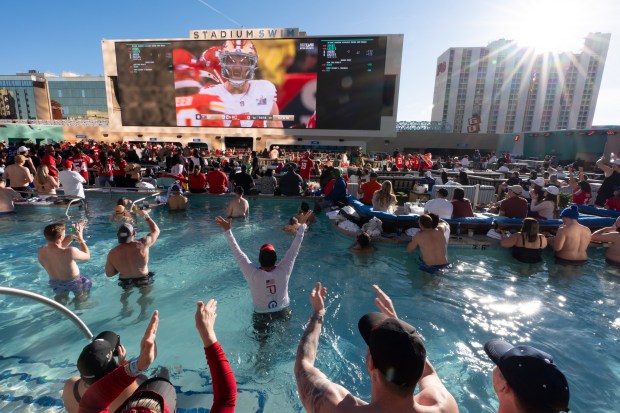
Warren was thoroughly impressed with how the city handled arguably the most extravagant event in sports, with so much happening during the entire week before Super Bowl Sunday.
“The way Las Vegas performed,” Warren said, “that won’t be their last Super Bowl. So I sit there and I say, ‘That’s what Chicago should be able to do.’”
Not long ago, Vegas was known primarily as a gambling and entertainment mecca. But now, with three established professional franchises, a fourth on the way and a stadium capable of hosting a range of major events, the city has become a draw for sports fans.
The Las Vegas Convention and Visitors Authority predicted this year’s Super Bowl would have an economic impact of at least $500 million on the city, according to the Las Vegas Review-Journal. The U.S. Chamber of Commerce reported the total economic output in Arizona for Super Bowl LVII in 2023 — played at State Farm Stadium in Glendale — was $1.3 billion.
Just this past week, State Farm Stadium also hosted the men’s college basketball Final Four, with attendance for Monday’s Connecticut-Purdue championship game topping 74,000.
Allegiant Stadium will host the Final Four for the first time in 2028.
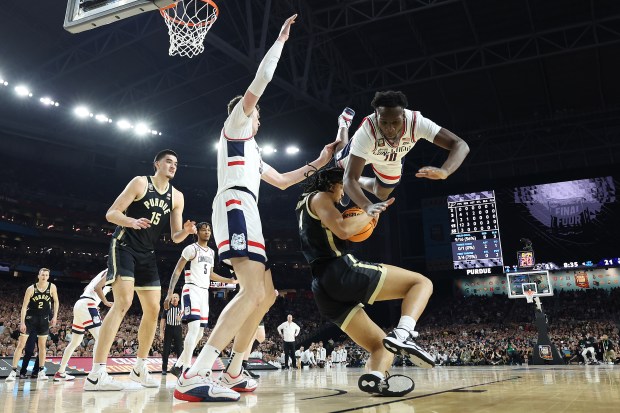
Warren envisions a new Chicago stadium working its way into that cycle in addition to becoming an attractive site for Super Bowls and other sports and entertainment mega-events.
Some economists balk at the economic impact figures released for such events, especially in places already established as tourism centers, noting that fans at those events may simply be displacing other tourists.
It’s also fair to wonder whether a new domed stadium on the Museum Campus would draw events away from other Chicago venues. Soldier Field, the United Center and Wrigley Field already serve as major concert venues, with Soldier Field hosting Taylor Swift’s “The Eras Tour” for three nights last summer and back-to-back Beyonce shows the following month.
But Douglass Morgan, who was the chief regulator and chairwoman of the Nevada Gaming Control Board before joining the Raiders, also emphasized the wide range of events Allegiant Stadium has proved capable of hosting, from small private parties and banquets to convention gatherings to soccer games and rugby matches.
More than 4 million fans have attended events at Allegiant Stadium since it opened, the Review-Journal reported last month.
As the wife of former cornerback Don Morgan, who spent three seasons with the Vikings and one with the Arizona Cardinals, Douglass Morgan said, “I knew what that NFL Sunday looks like around a (stadium).”
But now, all the other events now held at Allegiant Stadium, she said, have “made this a community asset we never had before and honestly never really understood could happen until it was actually alive and running.”
Indianapolis: A sweetheart deal?
Requests for public assistance in financing expensive stadium projects frequently are met with staunch opposition, which would be likely in Chicago. Earlier this month, voters in Jackson County, Missouri, overwhelmingly rejected a proposal for a 40-year sales tax increase that would have gone toward funding renovations at Arrowhead Stadium — the home of the Kansas City Chiefs — and subsidizing construction of a new ballpark for the Kansas City Royals.
That offered another reminder of the current climate on such matters, highlighting how difficult it may prove for the Bears to generate support for a new downtown stadium, especially one requiring substantial public funding.
While acknowledging some intangible social benefits from sports teams, economists generally frown on public subsidies for such projects. A University of Chicago survey of economists in 2017 found that 57% believed stadium subsidies were likely to cost taxpayers more than the economic benefits they generated, and only 2% disagreed.
An analysis of recent research found robust evidence that stadiums are “poor public investments.”
“Research consistently demonstrates that professional sports stadiums generate little to no tangible economic impacts in host communities; therefore, typical public subsidies for the construction of new stadiums generally exceed any meager economic benefits they may confer,” the paper concluded.
Nevertheless, lawmakers continue spending tax dollars on professional sports venues, to the tune of $19 billion since 2000 — sometimes even after voters have rejected such requests.
The nearest NFL city to Chicago, Indianapolis, claims great success in operating the retractable-roof Lucas Oil Stadium but had to pay dearly for it to open in 2008. It cost the public at least $620 million to build. Colts owner Jim Irsay paid $100 million with the public paying the rest, in part through a 1% sales tax.
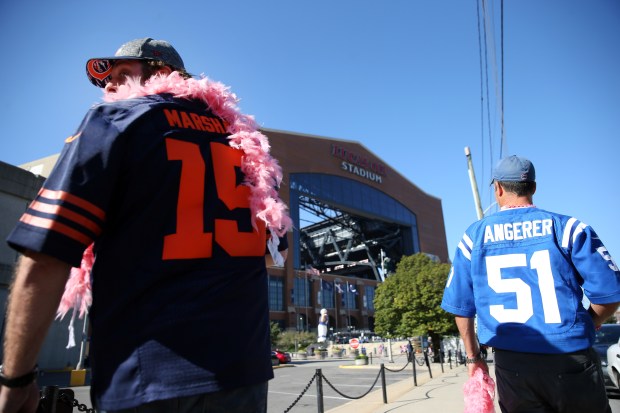
Critics have complained the Colts got a sweetheart deal. A University of Michigan study of 121 public-private stadium partnerships as of 2010 concluded that Indianapolis paid the most. The Indianapolis Star reported the Colts play in the stadium for $250,000 per year, pay nothing for maintenance while getting millions of dollars a year from other events, concessions and naming rights.
The stadium has operated in some years at a loss. During the COVID-19 pandemic in 2020, the stadium lost $41 million.
But Andy Mallon, executive director of the Capital Improvement Board that runs the stadium, said the investment in an enclosed facility has been worth it. The stadium is connected to the city’s convention center and hosts joint events from the Super Bowl to the Final Four to mega-concerts.
“For us, it’s a hugely successful investment because it allows us to do bigger and better and cooler things,” Mallon said. “Our event industry is 90% of tourism in Indianapolis. All the hotel rooms downtown depend on us bringing in these events.”
Reimagining what’s possible
Last month, when the Sports Business Journal released its ranking of the top 25 sports business cities in terms of event hosting, Chicago was notably absent. The list included Las Vegas, Los Angeles, Atlanta, Indianapolis, Minneapolis and Arlington, Texas — all NFL markets that opened new stadiums in the past 20 years.
Warren was mystified, and it also struck him that 10 other cities — including Detroit, Milwaukee, Nashville and Pittsburgh — were in a “Ones to Watch” grouping, recognized for having greater recent success in winning bids for sporting events.
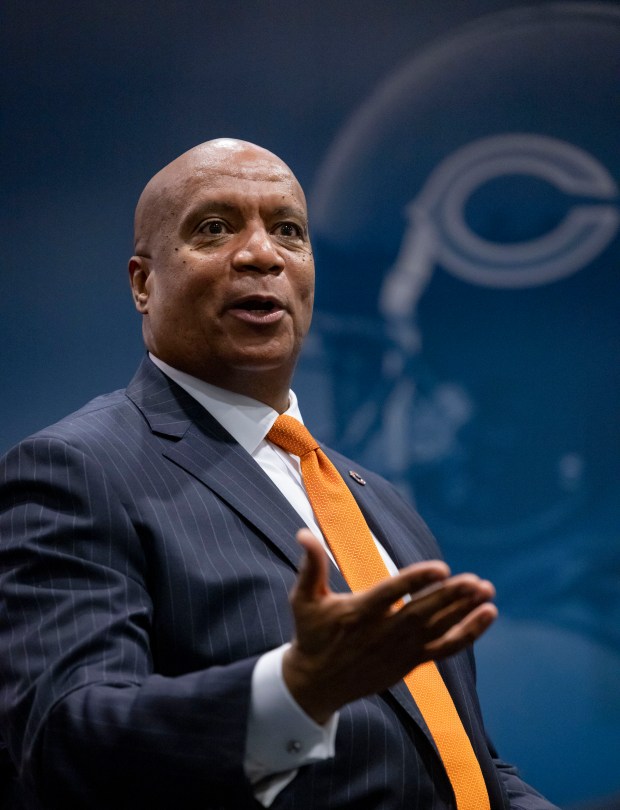
There’s no reason, Warren thought, Chicago shouldn’t be distinguishing itself with its ability to court and host events that also can have a positive economic impact.
Within the sports industry, a sentiment exists that Chicago hasn’t been a preferred destination for major events in part because of a perception that there’s no central organization to both court events and work directly with their rights holders. There also has been a sense of disconnect between the city’s sports commission and local and state governing bodies.
“The data speaks for itself,” said David Broughton of the Sports Business Journal. “The rights holders of these events are making a very conscious effort not to go to Chicago.”
The formula for the SBJ rankings was complex, and Chicago will need more than a new stadium to reshape its identity. But Broughton noted that this summer’s U.S. Olympic swimming trials — a nine-day event — will be staged in Indianapolis. At Lucas Oil Stadium. Yep, inside a football stadium.
Broughton labeled that “a game-changing event in our industry” as it relates to the growing trend of expanding the imagination about which sports and events can fit into which venues.
“This is an event that’s been in Omaha, Nebraska, inside a 9,000-seat arena forever,” Broughton said. “Now? If an Olympic swimming event can suddenly be staged inside an NFL stadium, then what are the limitations anymore as far as what sports can be in there? … Every opportunity you can use to show off your city is a great one.”
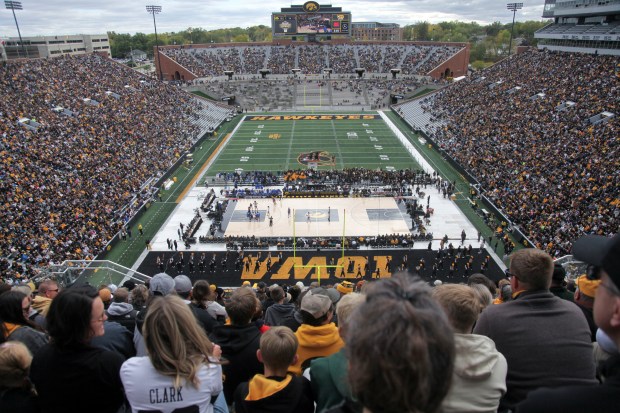
One of the ultimate goals for Chicago, Warren believes, is to be in play more regularly for sporting events both big and small. And if a closed-roof stadium downtown can advance that cause rewards can be reaped.
“In 2024,” Broughton said, “the goal is heads in beds. That’s why you go after these events beyond the mega-events. You’re not getting international viewers by the billions. … You’re looking to generate room nights. Because that generates the lodging tax revenues that help fund your buildings and your CVBs (convention and visitors bureaus).”
The Sports Business Journal recently documented a post-pandemic surge in cities and states focusing more heavily on sports-related tourism. Of the 22 states that currently have state-funded mechanisms to help attract and operate events — Illinois is not one — half have activated such funding since 2021.
For many municipalities, that has become a new marketing tool.
“Every person who comes into your city, if they have a good time, they’re going to come back,” Broughton said. “That multiplier you’re seeking is that from the 20,000 room nights you may generate (for a given event), a percentage of those people may return the next year when there’s not an event and at least stay in your hotels and see your sites and eat in your restaurants. That is the true multiplier.”
Arlington: A lift for the community
AT&T Stadium in Arlington, Texas — still known to many as “Jerry World” — has been evolving for almost 15 years under Cowboys owner Jerry Jones’ philosophy that no event is too big or too small to embrace.
Over the next four months alone, the building that serves as the Cowboys’ game-day home will host an RV show; a “Tacos and Tunes Festival”; concerts by Kenny Chesney, Kid Rock, Morgan Wallen and Zach Bryan; the Professional Bull Riders World Finals; a series of games in the Copa America soccer tournament; and the Mike Tyson-Jake Paul fight. The stadium also will host nine matches in the 2026 World Cup.
Since opening in 2009, the retractable-roof stadium — publicly owned by the city of Arlington with the Cowboys paying rent plus a portion of their naming-rights revenue — also has been the site of the 2010 NBA All-Star Game, Super Bowl XLV, Wrestlemania 32 and 38, the 2014 College Football Playoff championship game and the 2020 Rose Bowl. There have been countless other major attractions, from significant college sporting events to Manny Pacquiao fights to supercross and rodeo to mega-concerts by U2, Taylor Swift, Coldplay and Beyonce.
“The project itself becomes a focal point for all the uses and potential uses a venue like that can create,” Jones told the Tribune during a sitdown at the NFL owners meetings. “Just the process of expanding your imagination is very impactful. Honestly. We literally aren’t the same since the minute that venue came into place.
“It puts everyone associated with it on steroids. The teams that are involved. City officials. Your community. Everyone takes on a certain lift.”
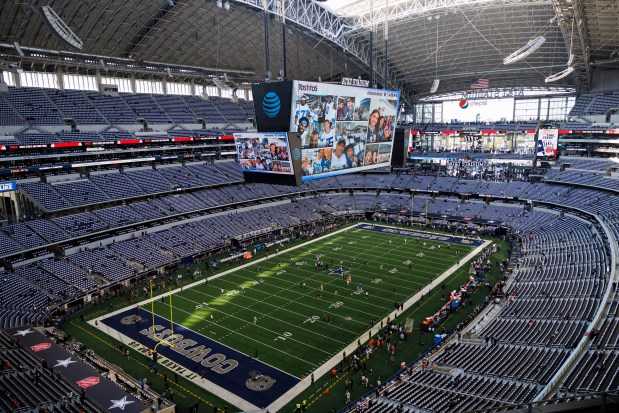
That’s why each time Jones listens to and absorbs the Bears’ evolving stadium wishes, he encourages them to think big.
As Jones has listened to McCaskey and Warren present their vision for a publicly owned, domed stadium in downtown Chicago, he has been magnetized to the ambitious energy. There’s clearly something here worth exploring, he said.
“I can’t overstate the energy that a venue done right can give a community,” Jones said. “That, in and of itself, creates multiplications of economic activity. But just as importantly, it puts center spotlight on your area.
“Now you may say, ‘Well, this area has always had the spotlight. This is Chicago.’ But I will tell you this right now. It can get brighter. It can get more intense. All in a positive way.”
Jones believes there’s immeasurable value in people just talking about a stadium. He noted how the Cowboys pushed the envelope with the expenditures and finishing touches they made to AT&T Stadium, which had a final cost estimated at $1.2 billion.
“For two-thirds of what we spent, we could have had a fabulous place for the Cowboys to play football,” Jones said. “But the final 20% to 30% of the money was spent not for the 100,000 (fans) who go in it. It was spent so (broadcasters) Al Michaels and John Madden could sit up there during games and go to 30 million viewers and say: ‘Folks, you ought to see this place! It’s pristine. It’s spotless. The quality of this.’ And they sit there and let the 30 million people who aren’t inside the stadium live vicariously.
“You can’t fool those people either. There has to be real meat on the bone.”

A new state-of-the-art stadium done well, Jones said, can heighten the Bears’ profile nationally and even globally.
Obstacles ahead
The momentum Warren alludes to eventually must become much more than anecdotal for a Bears stadium project to even taxi from the gate, much less get off the ground.
Pushback is likely from those who see far more pressing civic issues — education, crime and violence, the migrant crisis — than developing a venue for a football team and other entertainers.
The Bears also will have to be forthright in why all the benefits they’re propping up for their preferred city site wouldn’t be possible with a team-owned stadium and entertainment megaplex on the originally proposed site in Arlington Heights.
After all, it wasn’t long ago — in September 2022 — that then-team President Ted Phillips asserted during a community meeting in Arlington Heights that the Bears had a “singular focus” on the former Arlington Park site as the organization began sharing its vision for that sprawling complex.
Warren’s hiring as Phillips’ successor came less than four months later. And due in large part to ongoing property tax squabbles with both the Cook County assessor and three suburban school districts, the Bears say they have been persuaded to change directions.
Still, in Arlington Heights, officials have not given up.
The Bears face enough obstacles on the lakefront that Arlington Heights Mayor Tom Hayes thinks the team will end up using the site they own in the suburbs.
“They’ve got some very big hurdles to overcome on the lakefront,” Hayes said, “and ultimately we look forward to seeing them in Arlington Heights.”
Among those hurdles is the opposition to the lakefront site from Friends of the Parks, and the city’s Lakefront Protection Ordinance, which requires that the lakefront be for “public use.”
The nonprofit park advocacy group issued a statement last month raising concerns about surrounding development the Bears may propose. The group has proposed the former Michael Reese Hospital as being near downtown and off the lakefront, but team officials say the site is too narrow.
“We hope the Bears will show more vision and patience,” Friends of the Parks stated. “Instead of picking up their ball and going home, we urge them to toss balls around with stakeholders to find a way to stay home in a location that preserves our open, clear and free lakefront and is a boon for neighborhood development.”
Still, with Warren at the forefront, the Bears are making an aggressive pitch to keep the team playing on the Museum Campus with a finished product Warren believes can create impactful change for the Bears and Chicago.
Again, he cites Las Vegas, Minneapolis, Los Angeles and Indianapolis as models.
“They have made a concerted effort to come together,” Warren said, “not only as a business community but as a political community, a sports community, a civic community and from an operational standpoint to say, ‘Who do we want to be?’
“I think our stadium (pitch) provides the city of Chicago with the opportunity to decide who we want to be. And if we want to be that world-class city I know we are, this is an opportunity to come together.”
A larger, more formal proposal is coming soon.



